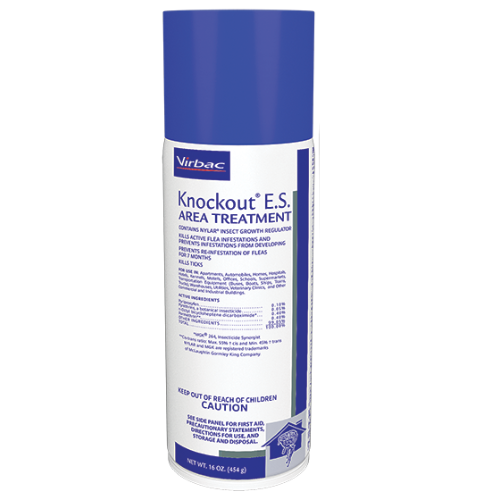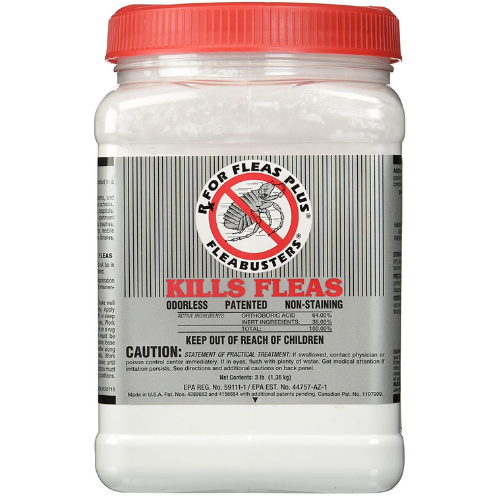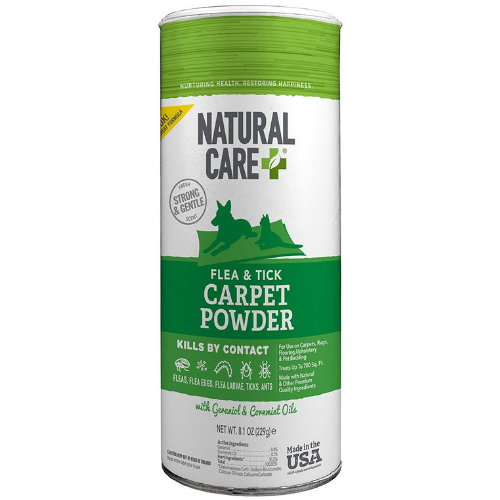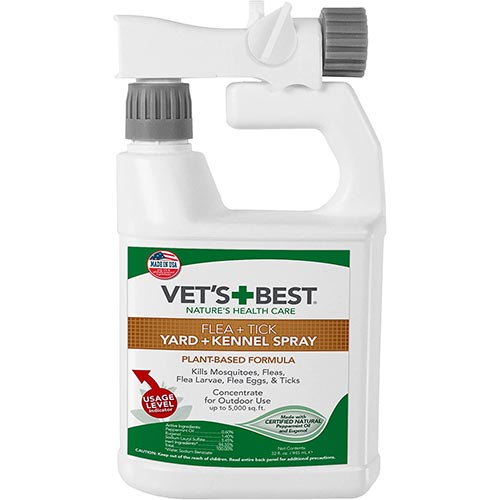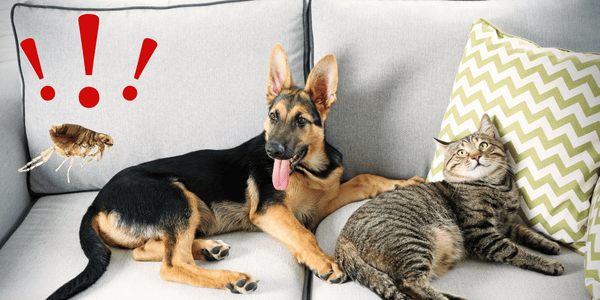
If you have ever experienced a flea infestation in your home or yard, then you’ll be nodding your head when I say getting rid of fleas once they make your home theirs is perhaps one of the most frustrating and time-consuming endeavors of pet ownership.
You often want to dive right in and buy the entire flea product aisle at your local pet store at the first sighting of a gnarly flea – however, hold your horses.
Before you waste your money and your time – your first "port" of call should be your veterinarian.
Your pet needs to be treated before you start trying to get rid of the fleas in your home. Your vet can guide you in the right direction by recommending effective preventatives, which can also act as a treatment, along with environmental management!
Skip Ahead
If You Just Treated Your Pet and Not Your Home – What Would Happen?
The presence of fleas on your cat or dog is, unfortunately, just the tip of the iceberg. There are actually many more flea eggs, larvae, and pupa just waiting to become adults, and these are typically hiding in carpets, cracks in wood floors, gaps in baseboards, bedding, blankets, couches, pillows, etc.
Therefore, treating the fleas on your pet is not an effective strategy on its own.
Yes, you may get rid of the flea at that moment in time; however, what will happen is new fleas will hatch, grow, develop, and ultimately jump back onto your dog or cat, and the cycle will continue.
10 female fleas can turn into 250,000 fleas in just 30 days!
See more flea facts below
Cleaning Your Home and Eliminating Fleas
In order to live flea-free, you need to clean your home while simultaneously ridding fleas from your pet. If you live in a house with a yard, your pets, house, and yard all need to be treated within a 24-hour period of each other.
Repeat treatment of your house and yard is important in about 3 to 4 weeks, and routinely treat the yard throughout the year, especially in areas where the weather stays warm, and humidity is generally high. Instructions on treating yards are below.
Step 1: See your veterinarian.
All pets in the home need to be treated, not just the one you found fleas on. If one pet is infected, they likely all are. Be sure to keep your pet(s) on their flea prevention and use it as directed by your veterinarian.
Make sure you understand the difference between over-the-counter and prescription preventatives.
Step 2: Wash ALL fabrics.
Shake your pet's bedding and any other fabric they sleep or rest on outside to get rid of as much flea dirt and debris as possible. It is best to do this in a sunny spot, as the sunshine helps kill flea eggs, and then make sure to treat this outdoor area for fleas as well.
Then wash everything in HOT water.
Do the same for your bed, pillows, couch, and chair cushion covers, as well as any area rugs and mats. Fleas love to make homes in fibers.
Ideally, once your washing cycle is done, you should hang everything outside in the sun. Alternatively, drying your washing on the HOT heat cycle is the next best option.
Step 3: Clean carpets, rugs, and furniture.
If it can’t be picked up and washed in HOT water, then you need to vacuum, vacuum, vacuum. Fully vacuum everywhere and then treat with a spray like Knockout. The vibrations of the vacuum will stimulate the eggs to start to hatch, which allows flea-killing treatments to work even better.
Shake and “punch out” your couch and chair cushions outside or over the carpet before vacuuming – this will aid in ridding any fleas, flea eggs, larva, and/or flea dirt that may be present on your cushions or couch covers.
Alternatively, steam cleaning works well also. Fleas aren’t likely to survive the heat and soap of a steam cleaner!
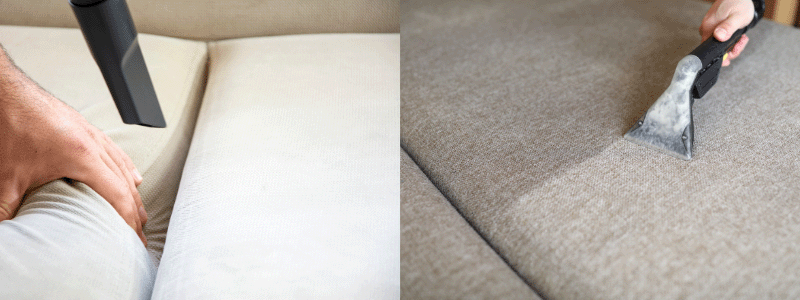
When we say vacuum, we mean vacuum EVERYTHING. Not just carpets, even if you don’t have carpets! Fleas can and do exist in homes that don’t have carpets, as they like crevices, such as baseboards, gaps between floorboards, as well as carpet flooring, ventilators, under furniture, and anywhere else, fur and lint accumulate.
And don’t forget to vacuum the rest of the couch that can’t be washed, as well as all those sneaky corners where food crumbs like to hide.
Many people don't realize how sticky larva is and that these eggs are not killed by the flea treatments until they start to hatch open — hence another reason to vacuum just prior to treating and why re-treating is almost always needed.
You will need to vacuum even if a professional is treating your home.
Flea Disposal Tip: Before vacuuming, try cutting up a flea collar and inserting it into the vacuum bag or canister. This can help aid in killing the fleas that are trapped inside and will further help in the garbage bag it will all be thrown into.
Bonus Tip: Leave a collar cut up in the vacuum after emptying it so it's there the next time your use the vacuum. Note: wash your hands after handling and cutting the collar.
Pre-treating carpet and upholstery with flea-eliminating powders:
You may wish to pre-treat with flea-treatment for carpets, such as FleaBustersRx or Knockout Spray. If using powder, you need to let it sit for 24 to 48 hours BEFORE vacuuming it up.
However, you should comb the powder into carpets and seams of upholstery so that you don't visibly see it. Any excess powder should be vacuumed. After 24 to 48 hours, vacuum everywhere thoroughly, then dispose of the sealed vacuum bag, ideally outside.
Why Borax shouldn't be used:
You may notice on the list of active ingredients in the FleaBusters product that there is an item named ‘orthoboric acid’ – also called hydrogen borate.
This is not to be confused with the toxic compound commonly known as Borax, also known as sodium borate, sodium tetraborate, or disodium tetraborate. These ingredients have previously been used in many flea-treatment powders. Borax is known to be toxic to pets, however, orthoboric acid is not.
You will want to be doing ALL of this washing and cleaning while your pets are, ideally, out of the home, as if they are part of the problem, you are going to be fighting an uphill battle.
So typically, I recommend, if possible, that one person take your pet(s) to the veterinarian for treatment while another stays home and cleans.
Plus, you do not want to expose them to the area treatments until they are vacuumed up or dried. Pets have walked in the powder or licked the spray before it dried and have been sick.
Step 4: Clean the vacuum.
If you have a bagless vacuum, you need to empty it into a trash bag when you’re done, seal the trash bag and throw it OUTSIDE. Then clean the canister and any detachable hose extensions you've used with hot soap and water.
Vacuuming will cause the flea eggs to WAKE up, and they’ll hatch and crawl out of your vacuum if you don't empty and clean it properly. If you have a vacuum with a bag, then you need to take the bag out to the trash right away.
While time-consuming, you'll actually end up saving time overall and getting the best results by fully emptying and cleaning the vacuum and hauling the "flea debris" off to the dump after every vacuum session, which should ideally be daily until you are 100% certain you have cleared the infestation.
Step 5: Treat the area and repeat vacuum steps
Treat all of the affected areas inside and outside thoroughly and stay out of your home for at least 3 to 4 hours after treatment, not returning until you are sure everything is dry. We always recommended boarding pets or having them stay with a friend or family member during the treatment process.
Many products used to treat fleas on pets start working within 6 hours, and generally, your pet gets treated the following day too, so inform the boarding facility so that they can isolate your pet appropriately.
How to Treat and Prevent Fleas in Your Yard
Use the Right Insecticide
Use insecticides that are formulated to kill fleas. Liquid forms, such as Ortho Home Defense Spray, tend to be better because once dry, pets and children can then walk in the yard.
Granule insecticides need to be watered in and take time to dissolve. If not, they can stick to your pet's paw pads, and they may ingest them. If you prefer a more natural route, you can try a flea treatment spray made from essential oils, like Vet's Best Flea and Tick Yard and Kennel Spray.
Check any product you use and follow the manufacturer's instructions carefully to ensure the safety of your pet. Wear gloves and wash your hands after application. If you spill the product on the ground or on your clothes, clean it up and change clothes immediately.
What About Diatomaceous Earth for Fleas?
Diatomaceous earth is a non-chemical alternative to sprays that can be fairly effective in killing fleas. It's a fine silica-based powder made up of fossilized aquatic organisms called diatoms.
According to the National Pesticide Information Center, "Diatomaceous earth causes insects to dry out and die by absorbing the oils and fats from the cuticle of the insect's exoskeleton. Its sharp edges are abrasive, speeding up the process." It basically dries out the fleas to death – along with any other insect with an exoskeleton.
If you decide to use diatomaceous earth, be aware that it should never be used directly on pets. Breathing in diatomaceous earth can cause irritation in the nose and throat and shortness of breath for both humans and pets. It can also cause dry, irritated skin.
Keep Your Lawn Short and Dry
Keep your lawn short to expose the soil to the sun. Fleas try to avoid the sun as they prefer dark environments. But don't cut your grass too short! Too short, and insects that eat fleas (like ants and spiders) won't want to show up there either.
Keep your yard dry and tidy. Fleas thrive in humid environments and will seek out shady places to hide, such as yard debris or piles of leaves or branches. Prune your bushes and tree branches to allow more sun to penetrate through to the ground.
Control Rodents and Wildlife
Squirrels, rats, mice, and other wildlife are common carriers of fleas. Make sure your yard is clean of any food waste or covered areas that may attract rodents. Install rodent guards on bird feeders.
Discourage wildlife from visiting your yard by putting up fencing or barriers, and check any current fencing for loose boards or gaps where wildlife may slip through.
Beware of using rodenticides that could harm your pet. Learn safer options for rodent control here.
Flea Facts
- 10 female fleas can turn into 250,000 fleas in just 30 days!
- It only takes one flea to cause an infestation. And that is because one single female adult flea can lay up to 40 eggs in one day! And, for every single flea seen, it is estimated that approximately 50 adult fleas are actually present!! That’s 300 fleas that are in existence in your home or on your pet for every 6 fleas you count!
- Although small in stature, adult fleas are capable of jumping approximately 6–8 inches upwards and 13 inches horizontally! Making the transition from one location to another – such as to your pet's fur – easy.
- In order to survive, fleas require a blood meal, meaning they use the animals that they bite as their food source. In addition to dogs and cats, fleas feed off of squirrels, raccoons, mice, and other wild, warm-blooded mammals outdoors – some of which come indoors.
- Fleas don’t particularly like biting or feeding on people, so if you or your family members are being bitten, then that means there is a particularly high flea population present inside your home!
- Fleas can carry several diseases that can affect your pet AND your family. For humans, while rare, a flea bite can transmit typhus, cat scratch fever, and even bubonic plague.
- For cats, flea bites can transmit cat scratch fever. Then, if the cat scratches or bites a human, they can then become infected with the bacteria.
- Pets and children that live in homes with fleas can accidentally ingest them, resulting in tapeworms as well.
The Flea Life Cycle
There are four flea life cycle stages: the egg, then the larvae, the pupa (where they are in a cocoon), and finally, the adult. And depending on the environment, including the temperature and humidity, this lifecycle can take several weeks to months to complete. Hence, fleas are more active in the summer/warmer months as they prefer warmer, humid climates.
However, with indoor heating, fleas can be a nuisance all year long.
The pupal stage is often when the flea lifecycle remains dormant, waiting for more favorable conditions as this stage is protected by a cocoon.
So, if you didn't clean your home environment well, you will end up with more fleas in approximately 1–2 weeks, and the cycle will continue.
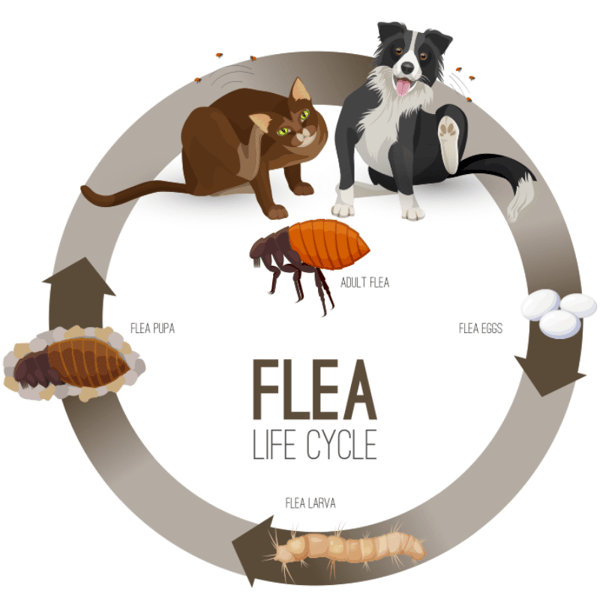
Keeping all this in mind, treating a flea infestation requires a multipronged approach in order to tackle every stage of their lifecycle and break the cycle. Treating all the pets in your home, as well as cleaning well, is paramount to getting an infestation behind you.


